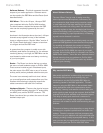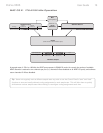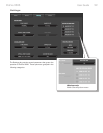
User Guide 18ProFire 2626
Why are software returns disabled?
When the interface operates at higher sample rates (i.e., 88.2/96 kHz or 176.4/192 kHz), certain hardware
input and output ports become disabled due to S/MUX II and S/MUX IV operation. When this happens, the
Control Panel automatically scales the number of software return channels to match the number of hardware
outputs. See the section entitled “Architecture of ProFire 2626” to learn about which specific hardware I/O and
software return channels become disabled at various sample rates.
NOTE: If you wish to use the DSP Mixer of ProFire 2626 for input monitoring, be sure to mute your DAW
application’s recording channels (or, if possible, turn off the application’s monitor mixing functionality altogether)
to prevent two separate cue mixes from being created (this can cause undesirable effects such as phasing and
slap-back delays). Conversely, if you wish to use your application’s own monitor mixing capabilities, you will
most likely want to bypass the ProFire 2626 DSP Mixer to prevent “double-monitoring” from taking place.
The DSP Mixer can be bypassed by either muting all of its input channels or by making sure that the Mixer’s
outputs are not routed to any hardware outputs in the Router (see the following section to learn more about the
Router).
Keep in mind that that the DSP Mixer channels have up to seven auxiliary sends* that can be shown or hidden using the
“+” and “–“ buttons ( ) on the right side of the mixer. Hiding an aux send channel does not disable the channel but
simply allows the row of aux sends to be hidden to minimize the size of the Control Panel. Each row of auxiliary sends also
has its own mute ( ) button allowing you to quickly silence the mix created by its associated row of aux send knobs.
Aux sends can be routed to any of the hardware outputs on the interface via the Router tab and can be used to send
signals to external effects processors just like an Aux Send on a traditional mixing console. Another common use of
this functionality is to create custom cue mixes for separate performers (this topic is covered in “Example Scenario #1”
section of this guide). The aux sends are in stereo and will always maintain the pan settings made in the DSP Mixer
channels.
* When operating at 176.4 or 192 kHz sample rates, the number of available auxiliary sends is reduced to one.


















